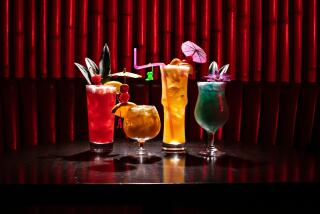Titan of Tiki
- Share via
Sven Kirsten dreams of enormous pagan godheads and cascading waterfalls, luau huts and tropical drinks with umbrellas, pu-pu platters. It’s not delirium; it’s not a desperate subconscious plea for a vacation. It’s love. Kirsten is the Big Kahuna of Tiki, the tacky mutation of Polynesian architecture and lifestyle that flourished in Southern California in the ‘50s and ‘60s.
“I see myself as an urban archeologist in the tradition of the great European exployers, discovering a lost culture,” he says, exaggerating only a little.He’s written several articles and a book on Tiki. He leads tours of local tiki sites. The BBC sought him out for a documentary on tiki culture. He leads a dedicated group of tiki devotees who hold lauau style meetings, tiki symposiums and slide shows on tiki then and now.
This Polynesian Pop style began in Hollywood with the first Don the Beachcomber restaurant in the 1930s, then took off in the ‘50s and ‘60s with the rise of surf culture. Soon tiki motifs were everywhere: in restaurants, apartment houses, motels, backyards
But over the past two decades, tiki began to fade, and many of its buildings were demolished or remodeled, Kirsten, a cinematographer (“Mistress,” “Liquid Dreams”0, laments the loss of “the whimsy and weirdness of the theme is unique,” he says. “Tiki just lets the fantasy go, without being bound by the constraints of good taste.”
More to Read
Sign up for The Wild
We’ll help you find the best places to hike, bike and run, as well as the perfect silent spots for meditation and yoga.
You may occasionally receive promotional content from the Los Angeles Times.






